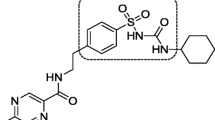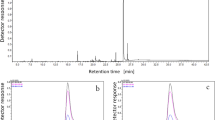Abstract
Background
The binding of three new aminopropan-2-ol compounds briefly called 2F109, ANBL and TWo8 with potential cardiovascular activity to bovine serum albumin (BSA), α1-acid glycoprotein (AGP) and to rat serum was studied. The chemical structures of these compounds are related to carvedilol. They possess an antiarrhythmic and hypotensive activity, and β- and α-adrenolytic mechanism of action. All analogues are weak bases with pKa values 8.65,8.85 and 8.26 for 2F109, ANBL and TWo8, respectively, and they possess lipophilic character (log P > 1.9584).
Methods
The extent of protein binding was determined using equilibrium dialysis in the range 2.5–900 μM, and 2.5–300 μM for binding of investigated compounds to BSA and AGP, respectively, and the quantitative measurement was done by LC/ESI-MS/MS assay.
Results
The studied compounds bound to a single class of binding sites on BSA which was characterized by low affinity (Kj for 2F109 = 8.49 × 10-5 M, for ANBL = 1.92 × 10-5 M, and for TWo8 = 1.71 × 10-5 M) and low capacity (n = 0.53 for 2F109,0.132 for ANBL and 0.13 for TWo8). The binding of 2F109, ANBL and TWo8 to AGP revealed one class of binding sites, with moderate affinity (Kd for 2F109 = 4.67 × 10-6 M, for ANBL = 3.48 × 10-5 M, and for TWo8 = 1.13 × 10-5 M) and higher capacity (n = 2.21 for 2F109, 2.76 for ANBL and 2.28 for TW68).
Conclusion
The obtained data indicate that 2F109, ANBL and TWo8 moderately bind to BSA (34.2–71.2%) with low capacity (Ka = 6.21 × 10-3–7.61 × 103M-1) and strongly bind to AGP (71.5–85.5%)with moderate affinity (Ka = 7.94 × 104–4.73 × 105M-1).
Similar content being viewed by others
References
Ascoli GA, Domenici E, Bertucci C: Drug binding to human serum albumin: abridged review of results obtained with high-performance liquid chromatography and circular dichroism. Chirality, 2006, 18, 667–679.
Atcheson B, Taylor P, Pillans P, Tett S: Measurement of free drug and clinical end-point by high-performance liquid chromatography-mass spectrometry. Application and implication for pharmacokinetic and pharmacodynamic studies. Anal Chim Acta, 2003, 492, 157–169.
Bickel MH, Graber BE, Moor MJ: Distribution of chlor-promazine and imipramine in adipose and other tissues of rats. Life Sci, 1983, 33, 2025–2031.
Daniel WA: Mechanism of cellular distribution of psychotropic drugs. Significance for drug action and interactions. Prog Neuropsychopharmacol Biol Psychiatry, 2003, 27, 65–73.
Daniel WA: Role of lysosomal trap** in the cellular and body distribution of drugs. Nova Acta Leopold, 2003, 87, 101–111.
Dingemanse J, Appel-Dingemanse S: Integrated pharmacokinetics and pharmacodynamics in drug development. Clin Pharmacokinet, 2007, 46, 713–737.
Groszek G, Nowak-Król A, Wdowik T, Świerczyński D, Bednarski M, Otto M, Walczak M, Filipek B: Synthesis and adrenolytic activity of l-(1H-indol-4-yloxy)-3-(2-(2-methoxyphenoxy)ethylamino)propan-2-ol analogs and its enantiomers. Part 2. Eur J Med Chem, 2009, 44, 5103–5111.
Kopecký V Jr, Ettrich R, Hofbauerová K, Baumruk V: Structure of human α1-acid glycoprotein and its high-affinity binding site. Biochem Biophys Res Commun, 2003, 300, 41–6.
Kratochwil NA, Huber W, Müller F, Kansy M, Gerber PR: Predicting plasma protein binding of drugs: a new approach. Biochem Pharmacol, 2002, 64, 1355–1374.
Liu ZQ, Jiang ZH, Chan K, Zhou H, Wong YF, Bian ZX, Xu HX, Liu L: Pharmacokinetic interaction of paeoniflo-rin and sinomenine: pharmacokinetic parameters and tissue distribution characteristics in rats and protein binding ability in vitro. J Pharmacol Sci, 2005, 99, 381–391.
Lullman H, Wehling M: The binding of drugs to different polar lipids in vitro. Biochem Pharmacol, 1979, 28, 3409–3415.
Maclntyre A, Cutler DJ: The potential role of lysosomes in tissue distribution of weak bases. Biopharm Drug Dispos, 1988, 9, 513–526.
Mather LE: Anatomical-physiological approaches in pharmacokinetics and pharmacodynamics. Clin Pharmacokinet, 2001, 40, 707–722.
Matsuda R, Anguizola J, Joseph KS, Hage DS: Analysis of drug interactions with modified proteins by high-performance affinity chromatography: binding of gliben-clamide to normal and glycated human serum albumin. J Chromatogr A, 2012, 23, 114–122.
Oravcová J, Böhs B, Lindner W: Drug-protein binding sites. New trends in analytical and experimental methodology. J Chromatogr B Biomed Appl, 1996, 23, 1–28.
Schmidt S, Gonzalez D, Derendorf H: Significance of protein binding in pharmacokinetics and pharmacodynamics. J Pharm Sci, 2009, 99, 1107–1122.
Trainor G: The importance of plasma protein binding in drug discovery. Expert Opin Drug Discov, 2007, 2, 51–64.
Walczak M, Szafarz M, Szymura-Oleksiak J, Groszek G, Bednarski M, Filipek B: Application of liquid chromatography-tandem mass spectrometry method for the analysis of new nonselective β-adrenergic blocker 1-(1-H-indol-4-yloxy)-3- [2-(2-methoxyphenoxy) ethylo]aminopropan-2-ol (2F109) in rat plasma. Chirality 2007, 19, 536–541.
Walczak M, Szymura-Oleksiak J, Groszek G: Enantiose-lective LC/ESI-MS/MS analysis and pharmacokinetic and tissue dystribution study of (2RS)-l-(7-methoxy-lH-indol-4-yloxy)-3-(2-(2-methoxyphenoxy)ethyl-amino)propan-2-ol in rats. Chirality, 2012, 24, 591–599.
Wan H, Rehngren M: High-throughput screening of protein binding by equilibrium dialysis combined with liquid chromatography and mass spectrometry. J Chromatogr A, 2006, 1102, 125–134.
Wright JD, Boudinot FD, Ujhelyi MR: Measurement and analysis of unbound drug concentrations. Clin Pharmacokinet, 1996, 30, AA5–A62.
Yang Y, Engkvist O, Llinàs A, Chen H: Beyond size, ionization state, and lipophilicity: influence of molecular topology on absorption, distribution, metabolism, excretion, and toxicity for drug like compounds. J Med Chem, 2012, 55, 3667–3677.
Author information
Authors and Affiliations
Corresponding author
Rights and permissions
About this article
Cite this article
Walczak, M. Binding of new aminopropan-2-ol compounds to bovine serum albumin, α1-acid glycoprotein and rat serum using equilibrium dialysis and LC/MS/MS. Pharmacol. Rep 65, 1294–1303 (2013). https://doi.org/10.1016/S1734-1140(13)71487-7
Received:
Revised:
Accepted:
Published:
Issue Date:
DOI: https://doi.org/10.1016/S1734-1140(13)71487-7




